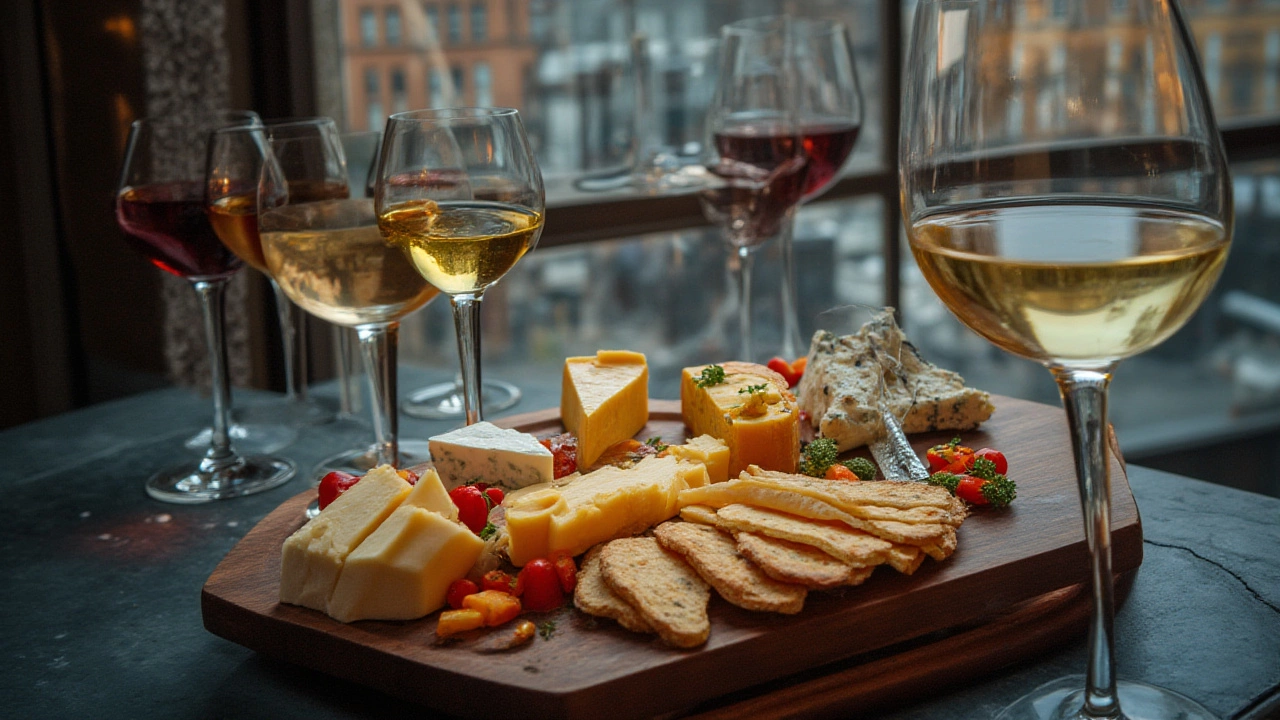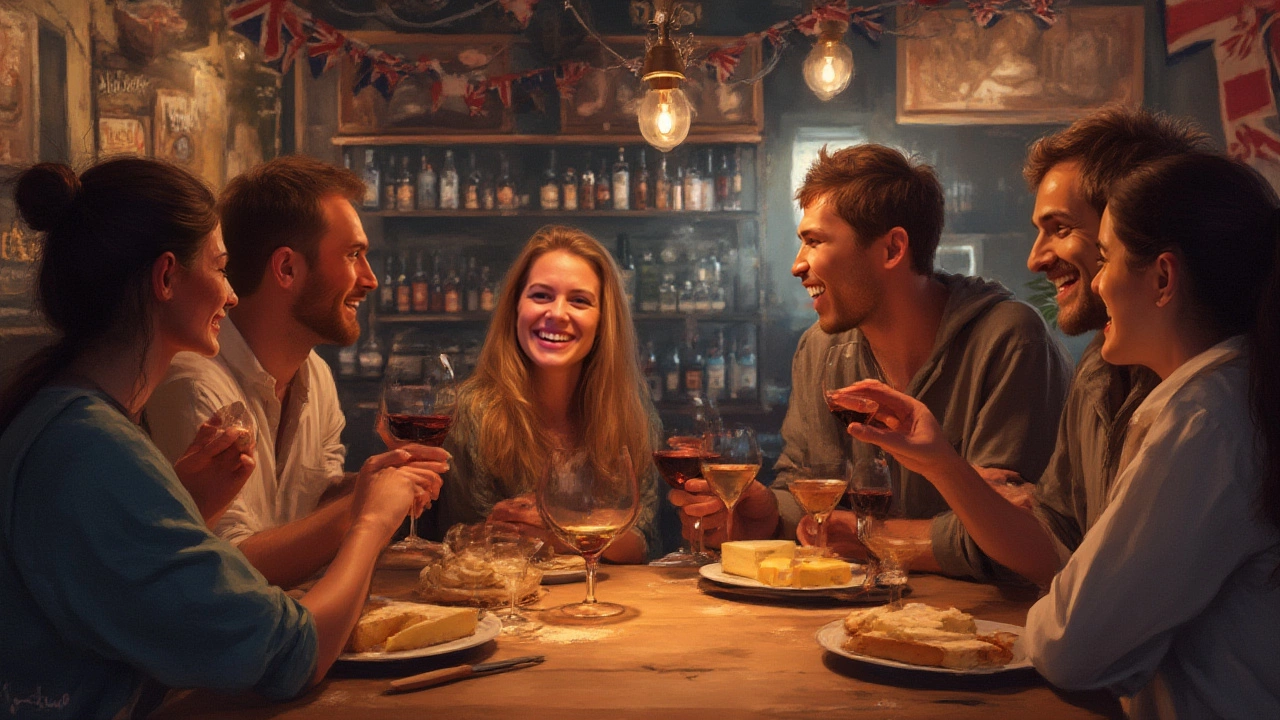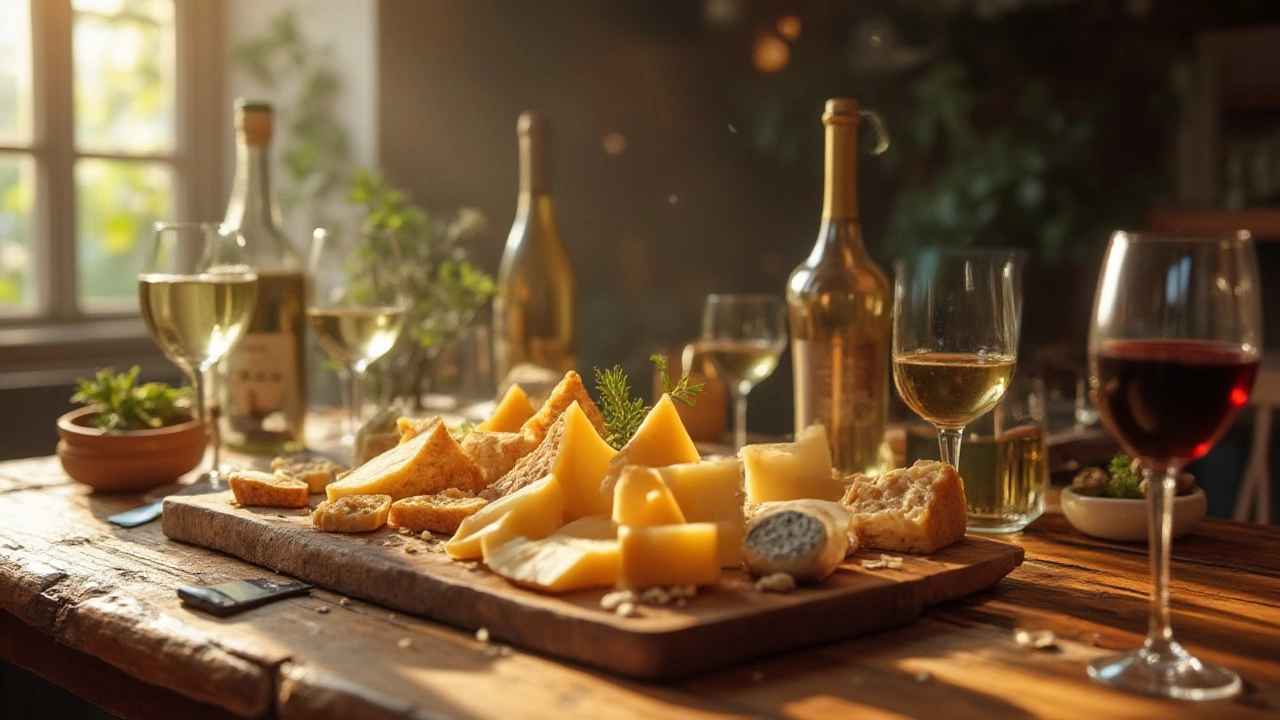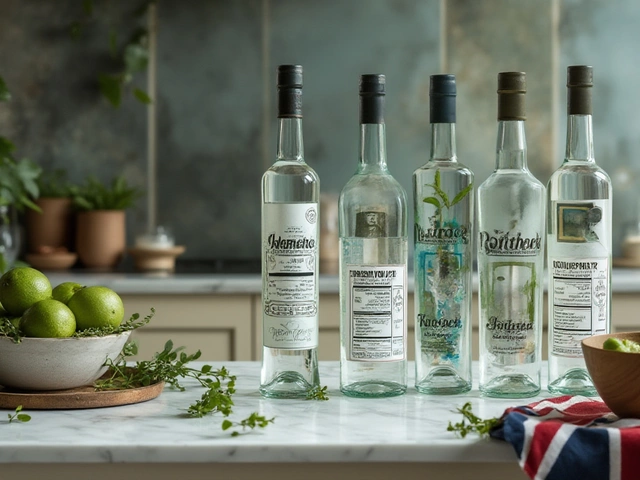Picture this: a table loaded with cheese, the sun dipping low over a Sydney rooftop, and a row of clinking wine glasses ready for action. You can sense that delicious anticipation thick in the air, right? But here's the twist—when the first guest reaches for the bottle, the question hits: do you pour white or red wine to go with that creamy Brie or sharp Cheddar? This isn't just a snobby wine question reserved for connoisseurs in French cellars. It's the secret sauce behind mixing simple pleasure with outright joy, and, let's face it, nobody wants to mess it up. The answers are surprisingly delicious, and once you've sorted it out, your gatherings will never taste dull again.
The Basics: What’s Really Happening When Cheese Meets Wine?
Cheese and wine look like an obvious couple—at the fanciest restaurants or the most casual backyard hangouts, you'll see them side by side. But have you ever wondered what really makes them click, or sometimes clash? It boils down to the science in food pairing. Cheese is full of fat and protein, which gives it rich, often salty flavors and creamy textures. Wine, on the other hand, is loaded with acids and tannins (those compounds that make your mouth feel dry) or, if it’s white, just the tanginess of the grape itself.
When you eat cheese, the fat coats your palate, smoothing out those sharper, sometimes bitey notes in wine. Think of cheese as turning down the volume on harshness so you can taste the more subtle stuff, like fruits and flowers in your glass. Red wines usually have higher tannins, especially your bold Shiraz or Cabernet Sauvignon. These need robust cheeses that can stand up to them, like aged Cheddar or hard Parmesan. If you pair a soft, delicate cheese with a tannic red, the wine will bulldoze the flavors, making the cheese taste bland or even weirdly metallic.
White wines, though, don’t usually have tannins to contend with. Instead, their crisp acids cut through the richness of cheese like a clean wave, so they’re gentler with delicate cheeses. That’s why sommeliers obsess over white wines with Brie, goat’s cheese, or fresh mozzarella. It’s all about that zing—think of a tangy Sauvignon Blanc paired with creamy goat cheese. The combination lifts the flavors sky-high, clearing the palate for the next bite.
There’s more at play, like the amount of salt and age in cheese, or sweetness in your wine. For example, blue cheese is wild with sweeter wines—ever had Stilton with a honeyed Sauternes or Roquefort with Tawny Port? It’s the kind of match that feels almost criminally indulgent. Just so you know, that’s not by chance. It’s all chemistry and centuries of trial and error.
Across cultures, pairings got shaped by what grew best side by side. The French love their Camembert with Chardonnay. Italians serve Parmigiano with Chianti. In Australia, fresh goat cheese with local Hunter Valley Semillon is a trend you’ll spot at every food festival. So when you pick a wine, you’re not just picking a bottle. You’re tying the flavors together from farm to table, and, sometimes, from one side of the world to the other.
If you want to pull off a great match every time, here’s a simple tip: judge how strong the cheese is and how bold the wine is. Lighter, subtler cheeses love a gentle companion, so go with white. Big, salty, mature cheeses want something with muscle—usually a punchy red.

White Wine with Cheese: Lightness, Zing, and Surprising Power
If you think only red wine takes cheese seriously, think again. White wine is quietly the hero of most cheese boards, backing up all sorts of creamy, crumbly, and even stinky varieties without stealing the show. That’s because of acidity, which acts like a squeeze of lemon to wake up your palate. Let’s break down some of the real stars in the white wine and cheese world—and why they work.
First, let’s talk fresh cheeses. Think creamy goat cheese (chèvre), ricotta, or feta. These cheeses are usually tangy, soft, and spreadable. Pour yourself a brisk Sauvignon Blanc, and you’ll see magic happen. The grassy freshness in the wine and the citrus zip cut neatly through the creamy, slightly sour cheese. If you’re at a Sydney market, pick up local chèvre and try it with a bottle from Adelaide Hills—chef’s kiss, seriously.
Move on to bloomy cheeses, like Brie and Camembert. They’re the fancy white rounds you see on every party table, gooey inside, slightly mushroomy. Here, Chardonnay (especially if it’s unoaked) is a knockout. The wine’s roundness matches the cheese’s creaminess, while its crispness keeps things from feeling too heavy. Don’t have Chardonnay handy? Champagne or any good sparkling white delivers a little zing and the bubbles help scrub your tongue clean. That’s the trick behind those fancy cheese-and-champagne pairings at weddings—bubbles + butterfat = love story.
But it’s not just about softness. Hard cheeses like Gruyère, Comté, and Emmental adore white wines too. Especially when the wine packs a punch, like an oaked white Burgundy or a richer Australian Semillon. These whites have a little structure and, paired right, their fruitiness brings out the nutty, sweet hints in the cheese. Slide a piece of Comté across your tongue and chase it with a sip of full-bodied Chard—mouth party unlocked.
What about stinkier cheeses? Surprisingly, a slightly sweet white wine, like Riesling or even a Moscato, can rescue those wild flavors without being shy. Take blue cheeses—nobody expects Riesling to outshine Roquefort, but the combo is legendary. The touch of sugar softens the bite and the acidity keeps things moving. Don’t believe me? Pop open a late harvest Riesling and try it with a bite of Gorgonzola. Suddenly, sweet and salty aren’t fighting anymore—they’re dancing.
Pro tip: if you’re building a cheese plate for white wine, pay attention to textures, not just flavors. Creamy cheeses and wines with good acidity will wake up your taste buds every time. Add a few nuts, dried fruit, and some crusty bread, and you’ve got a board nobody can walk past.
Still not convinced? Here’s a cheat sheet of classic pairs:
- Goat cheese + Sauvignon Blanc
- Brie/Camembert + unoaked Chardonnay or sparkling wine
- Gruyère/Comté/Emmental + oaked Chardonnay or Semillon
- Blue cheese + late harvest Riesling or Moscato
- Washed rind cheeses (think Taleggio) + dry Riesling or Pinot Gris
It’s not just bar talk—this actually lines up with flavour chemistry and has been crowd-pleasing locals and guests in Sydney and around the world. Don’t be shocked if your next party ends with folks singing the praises of white wine. With cheese, it deserves the spotlight.

Red Wine and Cheese: Big Flavours, Bold Matches, and Occasional Surprises
Red wine and cheese sound like best friends, but stick the wrong duo together and one will drown out the other. The trick is to find bold cheeses that can hold their ground against big, tannic reds. Tannins—the stuff in red wine that dries out your mouth—love rich, salty, fatty foods. That’s why, if you pick a big red (like a Cabernet Sauvignon), you’ll want a cheese that’s older, firmer, and punchier. Think aged Cheddar, Gruyère, or Gouda.
Take cheddar, for example. When it’s been aged for a year or two, its sharp, nutty flavor blends beautifully with tannins, softening them and making both wine and cheese taste smoother. This isn’t just a British nostalgia thing—there’s solid science here. The salty fat in the cheese binds to tannins in your mouth, cleaning your palate between sips and making the red wine taste fruitier and richer.
Parmesan is another all-star. With a dense, crumbly texture and a salty, nutty punch, it barely flinches in the face of a big Barossa Shiraz or Bordeaux. (Try it with an Australian Shiraz and you’ll understand why these combos have made waves at every local cellar door I’ve visited.) The cheese softens the edges of the wine and unlocks hidden flavors—sometimes even hints of chocolate or tobacco that aren’t obvious otherwise.
But what about softer cheeses? If you pair creamy Brie or Camembert with tannic red, things often go sideways. Those delicate, milky flavors get swamped and the wine may taste metallic or bitter. That’s because there isn’t enough fat or salt to balance the tannins. If you’re set on red wine with Brie, pick a lighter, fruity one like Pinot Noir, Gamay, or even a young Grenache. These reds aren’t loaded with tannins, so they play nice with soft cheese. Case in point: Pinot Noir with Brie is a classic in the Yarra Valley for a reason.
And then there’s the wild world of blue cheeses. Most red wines (especially dry ones) just can’t handle that funky, salty hit. But if you go sweet—think a Ruby Port or a rich Australian Tawny—you’ll get that legendary salty-sweet combo that cheese fanatics rave about. It’s why, at every fancy steakhouse or after-dinner board, Stilton and port show up together.
Let’s look at the numbers for a second:
| Cheese Type | Best White Wine Pairing | Best Red Wine Pairing |
|---|---|---|
| Goat Cheese | Sauvignon Blanc | Pinot Noir (light-bodied) |
| Brie | Unoaked Chardonnay | Pinot Noir |
| Cheddar (aged) | Rich Semillon | Cabernet Sauvignon |
| Parmesan | Full-bodied Chardonnay | Shiraz |
| Blue Cheese | Sweet Riesling | Port (fortified) |
The chart makes it easy: hard, salty cheeses are best with reds; softer and funkier ones, especially the creamy or triple-cream crowd, do better with whites. But don’t get too worked up about rules. Sometimes, breaking them works wonders—try Manchego with Tempranillo or even a nutty Gruyère with a dry rosé. It’s all about what tastes good to you.
So, does cheese go better with white or red wine? It’s not about winning, it’s about finding the right vibe. If you want to boost your hosting game, start by building your cheese board around cheese and wine pairing that respect each other's strengths. Go bright with white, or bold with red—just match the intensity and you’re set. And here’s the best part: your taste buds get to call the shots. Nobody in Sydney—or anywhere else in the world, for that matter—ever complained when the wine and cheese were this good together.


